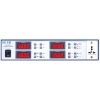- Voltage Regulators/Stabilizers[10]
- Transformers[10]
- Switching Power Supply[10]
- Inverters & Converters[10]
- Uninterrupted Power Supply (UPS)[10]
- Power Distribution Equipment[10]
- Elevator Parts[10]
- Car Stickers[10]
- Cable Ties[8]
- Cable Clips[1]
- Terminals[2]
- Plastic Film[8]
- Poster Materials[9]
- Advertising Boards[10]
- Reflective Material[4]
- Centrifuge Tubes[10]
- Medical Consumables[10]
- Contact Person : Mr. Zhu Clark
- Company Name : Shanghai Xishun Electric Co., Ltd.
- Tel : 0086-21-50115792
- Fax : 0086-21-50115793
- Address : Shanghai,Shanghai,Room 138, 1 Building, No. 218, Xianju Road, Zhujing Town, Jinshan District , Shanghai China (Mainland)
- Country/Region : China
- Zip : 201806
10KVA Single phase frequency power
Evolving from the original FKVF model, FKVF IPC variable frequency power supply has the following remarkable characteristics:
Waveform is square wave regulated by pulse width voltage.Operating function is optimized owing to the inner part being controlled by embedded IPC, making operation easier.Auto frequency sweep, the range of which can be set manually, searching for resonant point, 30-300Hz frequency range, max elapsed time being 2 seconds (full range sweep), and frequency resolution 0.01Hz.Auto test, the programme of which can be setup by user, with test programme being divided into 5 sections, and system automatically finish test according to the setup programme.When auto testing, it automatically tracks system resonant status, if something abnormal emerges, that’s to say resonant status exceed the setup area, the system automatically follows resonant point, which grantees an excellent working status of system during the entire procedure. (only HV system is possessed of this function)When auto testing, it can switch to manual control at any time, making manual frequency adjusting and manual voltage regulation possible.When doing voltage withstand, it automatically tracks voltage, the normal fluctuation of which makes it regulate voltage to target value automatically, whereas emerging of abnormal fluctuation will send a message to user who operate according to test condition.Real time drawing of U-T (voltage-time) curve and U/I-t (impedance-time) curve during voltage regulating and voltage withstand (note: U/I-t curve only for large variable frequency power supply)Real-time test status display for user to operate accordinglyStrong protection and alarming function: over current protection, over voltage protection, flashover protection, zero position protection, over heating protection, HV abnormality protection, concurrent protection and alarming of hard/software, which ensures safety and creates report files for inquiry.Auto save of test data, test report is produced which can be printed immediately or be saved and printed off site.Data inquiry function; inquire former test data based on inquiring condition.The primary reason for accurate frequency control is to allow the flow of alternating current power from multiple generators through the network to be controlled. The trend in system frequency is a measure of mismatch between demand and generation, and so is a necessary parameter for load control in interconnected systems.
Frequency of the system will vary as load and generation change. Increasing the mechanical input power to a synchronous generator will not greatly affect the system frequency but will produce more electric power from that unit. During a severe overload caused by tripping or failure of generators or transmission lines the power system frequency will decline, due to an imbalance of load versus generation. Loss of an interconnection, while exporting power (relative to system total generation) will cause system frequency to rise. Automatic generation control (AGC) is used to maintain scheduled frequency and interchange power flows. Control systems in power plants detect changes in the network-wide frequency and adjust mechanical power input to generators back to their target frequency. This counteracting usually takes a few tens of seconds due to the large rotating masses involved. Temporary frequency changes are an unavoidable consequence of changing demand. Exceptional or rapidly changing mains frequency is often a sign that an electricity distribution network is operating near its capacity limits, dramatic examples of which can sometimes be observed shortly before major outages.
Frequency protective relays on the power system network sense the decline of frequency and automatically initiate load shedding or tripping of interconnection lines, to preserve the operation of at least part of the network. Small frequency deviations (i.e.- 0.5 Hz on a 50 Hz or 60 Hz network) will result in automatic load shedding or other control actions to restore system frequency.
Smaller power systems, not extensively interconnected with many generators and loads, will not maintain frequency with the same degree of accuracy. Where system frequency is not tightly regulated during heavy load periods, the system operators may allow system frequency to rise during periods of light load, to maintain a daily average frequency of acceptable accuracy.
10KVA Single phase frequency power










